Grouping Parity 1 Sows With Gilts Improves Welfare, Performance
December 22, 2011

Grouping Parity 1 Sows With Gilts Improves Welfare, Performance
First-parity sows suffered more scratches and poorer farrowing performance compared to mature sows in group-housed gestation systems, according to research at the University of Minnesota.
By housing first-parity sows with gilts, aggression-induced injuries were reduced, fewer young sows were culled, and farrowing rates of first-parity sows improved. Thus, the production efficiency of group-housed gestation systems improved.
In most group-housing systems, gilts are housed separately to prevent aggression from older sows. However, after farrowing, first-parity sows are usually housed in pens with older sows. First-parity sows weigh about 25% less than mature sows — similar in weight to gilts — so it may be appropriate to house Parity 1 sows with gilts to reduce social stress.
A University of Minnesota study investigated the effects of housing first-parity sows with gilts on welfare and performance of young sows in a group gestation housing system located at the West Central Research and Outreach Center. All gestating sows and gilts were group-housed in a straw-bedded hoop barn. The gestation barn had four pens, 15 sows or gilts per pen. Each pen was equipped with individual feeding stalls and a bowl drinker with two spaces. Space allowance was 41 sq. ft. per sow.
Every 10 weeks, a batch of 35 to 40 females was mated within five days after weaning. Within each batch, two groups of females were mixed in each of two treatment pens after weaning and remained there throughout gestation.
The control pen included 11, parity 2 through 10 sows and four first-parity sows. The treatment pen consisted of 11 gilts and four first-parity sows.
Sows and gilts were weighed and assessed for body condition scores and backfat thickness before mixing and at the end of gestation. Injury scores were assessed before and 48 hours after mixing, and wean-to-mating intervals, farrowing rate and litter performance for the subsequent farrowing were recorded for all females.
Females in treatment pens sustained fewer scratches after mixing than females in control pens (Table 1). First-parity sows housed with gilts had lower injury scores (8 vs. 13) after mixing, gained more weight (130 vs. 79 lb.) during gestation and had higher farrowing rates (94% vs. 67%) compared with first-parity sows housed with older sows. The injury score system was: 0 = no injury (skin unmarked: no evidence of injury from aggressive behavior); 1 = slight injury (less than five superficial wounds); 2 = obvious injury (5 to 10 superficial wounds, up to three deep wounds, or both); 3 = severe injury (more than 10 superficial wounds, more than three deep wounds, or both). The assessment combined scores of 0 to 3 from 12 surface regions of the body: two ears, the snout, two shoulders, two flanks, two hindquarters, the back, the tail and the vulva with a maximum possible score of 36 for each sow.
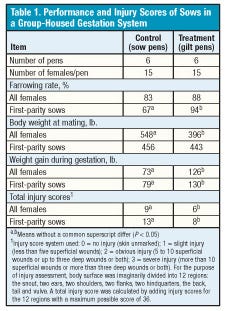
Sorting by parity did not affect wean-to-service interval, body condition, backfat thickness or litter performance of first-parity sows.
“These results suggest that sorting by parity shielded first-parity sows from severe injuries caused by mixing-induced aggression so that their welfare and performance can be improved in group housing systems,” says researcher Yuzhi Li.
Researchers: Yuzhi Li and Lee Johnston, West Central Research and Outreach Center, University of Minnesota. For more information, contact Li by phone (320) 589-1711, fax (320) 589-4870 or e-mail: [email protected].
Eating Patterns Differ in Large Group vs. Auto-Sort Pens
Research at the Prairie Swine Centre (PSC) has found that compared to conventional finishing pens, pigs in large-group, auto-sort (LGAS) pens modified their behavior by having fewer (five vs. 10-15) but longer meals. Pigs in LGAS pens only entered the food court 2-4 times each day.
LGAS pigs frequented all available feeder spaces within the food courts, visiting several each day, but had some difficulty learning to enter and leave the food court.
Most LGAS systems require pigs to pass through an automated scale as they move from the loafing area into the food court and return to the loafing area via one-way gates.
Common food court problems are too few feeders or feeder spaces that are blocked by pig traffic or pigs lying in the foot court.
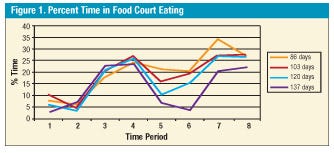
The study evaluated feeding and productivity in LGAS systems using two food court designs and studied feeding behavior and productivity in LGAS with conventional, small-group pens.
Studies were conducted at PSC and a grow-finish farm. Pigs at PSC were housed in small pens (18 pigs/pen, two feeders/pen) and in large pens (250 head, one feeder/nine pigs). Pigs were 10 weeks old when placed in experimental rooms. One room provided conventional, small-group pens and the other two rooms were modified for LGAS. The food court design in the two LGAS rooms differed; one had feeders in the center of the pen, while the other had feeders along the walls of the food court.
At PSC, researchers recorded the diurnal (daily) pattern of scale use, the use of individual feeder spaces within the food court and eating patterns of individual pigs in LGAS rooms.
The commercial farm maintained groups of 650 pigs with 60 feeder spaces. Feeding behavior was observed in 10 rooms to assess the diurnal pattern of feeding behavior at different ages. Output from the auto-sort scale was supplemented with live observations of four rooms of pigs at different ages over a 24-hour period.
The LGAS pigs consumed about five meals per day (during their 2-4 visits to the food court per day), and fed for a longer duration than in small-group pens. No differences were found in performance or feeding behavior for the two food court systems studied.
The study at the commercial farm allowed researchers to examine changes in eating behavior as pigs aged. The average number of entrances into the food court each day decreased as the size (age) of the pigs increased, from nearly four entries/day at 88 lb. to about 2.5 entries/day at 198 lb.
Eating patterns showed the typical diurnal pattern described earlier (Figure 1). Interestingly, this diurnal pattern demonstrated that younger pigs had less of a drop-off in the middle of the day, which suggests that the younger pigs were limited by the number of feeder spaces available and had to shift from eating during the normal peak periods to the less intensive midday period.
Overall, large-group, auto-sort systems posed some significant challenges in terms of pig eating behavior. Accessing feeders through an auto-sort scale is more costly than conventional small pens.
Researchers suggested that a key to making food courts work effectively is to make sure the pigs know food is present by introducing them to the food court rather than the loafing area. The food court should be spacious enough so that pigs have access to all of the feeders, and a feeder space should be provided for every 10-12 pigs.
Researchers: J.A. Brown, S. Hayne, T. Samarakone, B. Street and H.W. Gonyou, Prairie Swine Centre. For more information, contact Jennifer Brown by phone (306) 667-7442, fax (306) 955-2510 or e-mail: [email protected].
Static Force Plate Helps Identify Lame Sows
Lameness is a major reason sows are culled. It is estimated that 6-15% of sows are culled due to feet, leg and locomotion disorders, based on subjective methods.
An objective and standardized method for assigning lameness scores to sows would provide a more accurate means for producers to assess lameness.
In this study, faculty and students in Animal Science, Agricultural and Biosystems Engineering and Veterinary Diagnostic and Production Animal Medicine at Iowa State University designed and built a static force plate to measure weight distribution on four legs of a standing sow.
The automated plate is composed of durable aluminum, which provides the strength to withstand years of abuse by sow hooves and the harsh environment of a sow barn.
The available force plate systems typically require the sow to walk the entire distance of the force plate to collect locomotion data. This new design, however, allows the sow to stand on the force plate for extended periods of time (typically 15 minutes to one hour) to accurately collect weight distribution of each limb, and therefore lameness, throughout her productive life. This information could help producers implement environmental or genetic programs to decrease the occurrence of lameness in the sow herd.
The technology may also help identify lameness problems earlier and allow for more timely treatment or culling decisions. The force plate fits existing equipment.
Researchers: Kenneth Stalder; Anna Johnson; Locke Karriker, DVM; and Steven Hoff, Iowa State University. For more information, contact Stalder by phone (515) 294-4683, fax (515) 294-5698 or e-mail: [email protected].
Temperament, Floor Space, Mixing Addressed in Sow Housing Trials
Group sow housing trials found that most fighting and injuries occur within 24 hours of mixing, although no difference was found between space allowances.
The research at the Prairie Swine Centre (PSC) also determined that passive or shy sows are more likely suited to group housing than aggressive sows as they had lower injury scores and lower levels of salivary cortisol.
Sixteen groups of eight sows averaging 507 lb. were divided into uniform groups described as passive/shy or active/bold. Gestation pens consisted of 32 walk-in/lock-in stalls and a loafing area. Sows were confined to the loafing area for 23 hours per day and returned to the stalls for feeding. Movable panels created required space allowances of 17.2, 21.5, 25.8 and 30.1 sq. ft./sow, respectively.
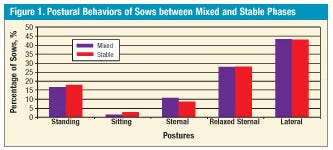
Aggressive behaviors were observed live for four hours after sows were mixed and photos taken at regular intervals for 72 hours post-mixing. Injuries were assessed and saliva samples collected before mixing, then at 24 and 72 hours post-mixing from four focal sows per group.
At the end of the “mixing week,” sows were weighed before being locked in their feeding stalls for one week. Sows were returned to stable groups for four weeks and assessed for injuries and saliva scores, and aggressive behavior was recorded.

On average, for sows mixed and in stable groups over a 24-hour period, 17.2% of sows were standing, 2.1% sitting, 9.6% lying on sternum, 28% lying relaxed on sternum and 43.1% lying laterally. Results were consistent for mixed and stable groups throughout gestation (Figure 1).
Calculations for space requirements indicated that sows require the most amount of space between midnight and 8 a.m (16.25 sq. ft.). and the least amount during the day (8 a.m. to 4 p.m.). However, these space requirements are for the physical space allowance alone and do not take into account the space requirement for movement or social interactions, etc.

When sows were initially grouped, they showed a higher occurrence of injury scores and a greater number of fights (Figure 2) compared to the stable groups.
Most fights occurred within 24 hours of mixing and were consistent across all four space allowances (Figure 3).
Sows in the stable groups showed a higher level of threats than the mixed groups. Threats didn’t escalate into physical contact due to the establishment of a dominance hierarchy.
Injury scores and number of fights recorded no significant differences with the different space allowances. Further investigation is required into the optimum space allowance for group-housed sows.
Researchers suggest that grouping sows with different behavioral characteristics did appear to minimize aggression.
Researchers: Fiona Lang and Jennifer Brown, Prairie Swine Centre. For more information, contact Lang by phone (306) 667-7442, fax (306) 955-2510 or e-mail: [email protected].
Pigs Moved to Large Pens Don’t Prefer ‘Home’ Pen Resources
Large pen configurations of 200 pigs or more are an option for some large production systems in the United States.
Producers using this approach often double-stock weaned pigs for several weeks, then open gates to create one large pen. Pigs from smaller pens intermingle in new surroundings and utilize new feeder and waterer resources.
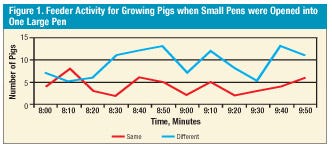
This study set out to determine if pigs preferred their “home” resources or new feeders and waterers in the large pen.
In one wean-to-finish system, pigs were double-stocked and kept in smaller pens for about eight weeks and then the back gates were opened to create one large pen. A total of 192 pigs in double-stocked pens (96 barrows and 96 gilts) received a color-coded tag in their left ear.
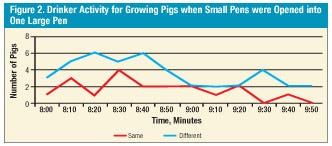
In the large pen, live observations were recorded with instantaneous, 10-minute scans for a two-hour period, immediately after the small pens were opened into a larger pen. The number of pigs at their home feeder or drinker, or their new feeder or drinker, was recorded.
Within the two-hour period of opening the pen gates to create the large pen, pigs were visiting foreign feeders and drinkers. Feeder and drinker activity is presented in Figures 1 and 2.
Researchers concluded that pigs showed no preference for home feeders or drinkers over their new options. The majority of pigs were engaging in other behavioral activities within the newly created large pen.
Researchers: Anna Johnson and Kenneth Stalder, Iowa State University; Leah Geasing, Mattew Ritter, Elanco Animal Health; Jim Moody, Tara Donovan, DVM, Eva Jablonski, The Hanor Company. For more information, contact Johnson by phone (515) 294-2098, fax (515) 294-9143 or e-mail: [email protected].
Hoof Abnormalities Affect Sow Behavior In Farrowing
A team of Iowa State University researchers evaluated the effects of excessive toe growth, hoof cracks in the outer hoof wall, and the length difference between the inside and outside toes on sow behavior in mid-lactation.
Studies were conducted on two 4,200-sow farms in the same Midwestern production system in 39-stall farrowing rooms.
Sows were classified into three treatment groups and one control group prior to being placed in farrowing stalls. The treatment groups were:
• Presence of cracks in the outer hoof wall (CK);
• Length differences between the medial and lateral toe of the hoof (TS); and
• Excessive toe growth (OG).
Some sows had both toe size differences and cracks in the outer hoof wall.
Time budgets were developed for three postures (standing, sitting, lying down). Sows in the control group spent 18.9% or 19.9 minutes of the 105-minute observation period standing, 1.3% or 1.4 minutes sitting, and 76.1% or 79.9 minutes of the time lying in a lateral or sternaposition.
Each increase in OG lesion score was associated with sows spending 54% less time standing. Control sows spent 12.7% or 13.3 minutes of the total time standing and eating.
Before feeding, control sows spent 1.2% of the time standing and eating. However, after feed delivery, sows increased the time spent standing and eating to 10.7%.
Researchers found no evidence that sows from the different treatment severity levels were associated with varying times spent standing and eating when compared to control sows. Post-feeding, each increase in overgrown lesion score was associated with a 40% decrease in time spent standing and eating, consistent with total time spent standing and eating during the observation period.
Sows in the CK group spent less time of the total observation period lying down compared to the control group. As the severity of overgrown lesions increased, total time spent lying down increased. In contrast, CK lesion scores were not associated with time spent lying down before and after feeding.
Researchers concluded that sows classified in the OG treatment group spent less time standing and eating as lesion severity increased when compared to control sows.
Researchers: Anna Johnson, Kenneth Stalder, Locke Karriker, DVM, Robert Fitzgerald, Iowa State University; Howard Hill, DVM, and Jeff Kaisand, DVM, Iowa Select Farms. For more information, contact Johnson by phone (515) 294-2098, fax (515) 294-9143 or e-mail: [email protected].
You May Also Like



